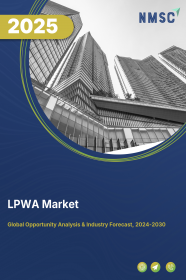
Low-Power-Wide-Area (LPWA) Market by Component (Hardware, Software, and Services), by Technology (LoRaWAN, Sigfox, NB-IoT, LTE-M, and Others), by Application (Smart Cities, Industrial Automation, Agriculture, Healthcare, and Others), by Frequency Band (Sub-gigahertz and Others), by Connectivity (Cellular, Satellite, and Others), and Others-Global Opportunity Analysis and Industry Forecast 2024-2030
US Tariff Impact on LPWA Market
Trump Tariffs Are Reshaping Global Business
Market Definition
The Low-Power-Wide-Area (LPWA) Market size was valued at USD 6.50 billion in 2023 and is predicted to reach USD 48.10 billion by 2030 with a CAGR of 33.10% from 2024-2030.
Low-power-wide-area (LPWA) is a type of wireless communication technology that enables low-power devices to connect to a wide-area network and communicate over long distances. LPWA networks are designed to be low-cost, low-power, and low-data rate, making them suitable for use in Internet of Things (IoT) applications, where long battery life, low cost, and wide coverage are needed.
They use low-power radios and can be deployed on unlicensed or licensed spectrum. The LPWA technologies include LoRaWAN, Sigfox, NB-IoT, and LTE-M. These technologies are designed to provide low-cost, low-power, and wide-area coverage. They are suitable for IoT applications that require low data rates, long battery life, and wide-area coverage. These technologies are expected to play an important role in the growth of IoT, as they can connect a large number of devices over long distances, at a low cost, and with low power consumption.
Market Dynamics and Trends
The demand for the LPWA market is increasing due to the growing adoption of IoT technology in various industries such as smart cities, industrial automation, and agriculture. This has led to an increase in the number of connected devices, which in turn has increased the demand for low-power communication solutions that can connect devices over a wide area, therefore driving the growth of the LPWA market. LPWA networks are well-suited for IoT applications as they can provide wide area coverage and low power consumption.
Moreover, the cost of deploying and maintaining communication networks has been a major concern for industries. LPWA networks are becoming more popular as they provide cost-effective and low-power consumption solutions for connecting devices, thus the increasing need for cost-effective solutions is further boosting the growth of the market. The LPWA networks use low-frequency bands, low data rates and are optimized for low power consumption which results in extending the battery life of connected devices and reduces the overall cost of deployment.
Additionally, the growing demand for smart city and smart home solutions is accelerating the growth of the Low-power wide-area (LPWA) market. Smart cities rely on a variety of connected devices to improve the quality of life for citizens and to make cities more efficient and sustainable. LPWA networks are well-suited for these applications as they can provide wide area coverage and low power consumption, allowing for the deployment of a large number of connected devices such as smart lighting, smart parking, and smart waste management.
However, LPWA networks are optimized for low data rates and are not suitable for applications that require high data rates such as video streaming or large file transfers. Therefore, the limited data rate capability of LPWA may restrain the growth of the market.
On the contrary, the integration of 5G is expected to provide low-latency and high-bandwidth connectivity, and when combined with LPWA networks, it will enable the deployment of more advanced IoT applications such as industrial automation, autonomous vehicles, and smart cities, which may create ample growth opportunities for the market in the future.
Market Segmentation and Scope of Study
The global LPWA market is segmented on the basis of component, technology, application, frequency band, connectivity, organization size, and end users, and geography. Based on component, the market is classified into hardware, software, and services. Based on the technology, the market is segmented into LoRaWAN, sigfox, NB-IoT, LTE-M, and others. On the basis of application, the market is categorized into smart cities, industrial automation, agriculture, healthcare, and others. On the basis of frequency band, the market is divided into sub-gigahertz and others. On the basis of connectivity, the market is categorized into cellular, satellite, and others. Based on organization size, the market is divided into SMEs and large enterprise. On the basis of end users, the market is categorized into utilities, transportation & logistics, manufacturing, and others. Geographical breakdown and analysis of each of the aforesaid classifications include regions comprising of North America, Europe, Asia-Pacific, and RoW.
Geographical Analysis
North America dominates the global LPAW market and is potently expected to remain dominant in the market throughout the forecast period. This is attributed to the rise in the number of smart city projects along with the adoption of smart homes in the region.
These technologies rely on LPWANs to connect and communicate with a large number of devices, thus, the rise in the number of smart city projects and the adoption of smart homes is expected to drive the demand for LPWANs in North America.
Moreover, the presence of major market players such as LORIOT and Qualcomm Technologies, Inc. that are adopting various strategies including product launches are further accelerating the growth of the market. For instance, in June 2022, LORIOT, launched a Hybrid Network Management System, sustaining both their existing LoRaWAN market-leading Network Servers and now the mioty Service Centers too.
This hybrid solution provides additional connectivity, greater flexibility, and a higher density of devices, to both existing and new clients, based on their specific use case requirements. This innovative technology has the ability to meet the needs of large-scale IoT projects, particularly in the industrial and metering sectors.
Also, in February 2022, Qualcomm Technologies, Inc. partnered with Microsoft to deliver a unique, industry-first chip-to-cloud solution for private enterprise networking designed to solve the technology adoption problem for enterprises to implement private 5G networks on a global scale. The collaboration aims to simplify and accelerate the 5G private network deployments by introducing a unique chip-to-cloud solution.
On the other hand, Asia Pacific shows substantial growth in the global LPWA market owing to the growing digitalization along with the rising adoption of IoT devices in various industries is further driving the growth of the low power wide area (LPWA) market in the Asia Pacific region.
As more and more industries are embracing digitalization, the demand for connected devices and IoT solutions is increasing. LPWA networks and devices are well-suited for these types of applications as they can support a large number of devices over a wide area with low power consumption.
Moreover, the growing research and development in the telecommunication sector particularly in countries such as China, Japan, South Korea, and India, where major telecommunications companies and research institutions are investing in the development of LPWA networks and devices.
For instance, in May 2022, Huawei 6G Research Team developed a prototype featuring ultra-low power consumption, ultra-high throughput, and ultra-low latency for short-range communications using the mmWave band 70 GHz. This prototype enables devices to communicate at a throughput higher than 10 Gbit/s (Giga bits per second) with sub-millisecond latency. The transmission rate is several times higher than that of wired USBs, and the power consumption of the entire system is less than 560 mW.
Competitive Landscape
Various market players operating in the LPWA market include Telefonica SA, Semtech Corporation, Huawei Technologies Co. Ltd., Cisco Systems Inc, Senet, Inc., Actility, LORIOT, SIGFOX, WAVIoT, and Qualcomm Inc. These market players are adopting various strategies such as innovation and collaboration to maintain their dominance in the global LPWA market. For instance, in January 2023, Semtech Corporation and Skyworks Solutions, Inc. launched the SKY66423-SX1261 reference design for low-power wide-area networks (LPWAN). This latest design leverages Skyworks solutions collective technologies in support of next-generation LPWAN deployments to meet the needs of smart home and smart city applications like security, automation and tracking.
Also, in November 2022, Semtech Corporation collaborated with Amazon Web Services, Inc. (AWS) to license its LoRa Cloud global navigation satellite system (GNSS) geolocation services to help the AWS global developer community build asset tracking and monitoring solutions and connect Internet of Things (IoT) enabled devices, using LoRa Edge, to the Cloud.
Moreover, in July 2022, Senet, Inc. partnered with Iota Communications, Inc. (“IotaComm”) to deliver LoRaWAN through both 915 MHz unlicensed spectrum and through IotaComm’s unique 800 MHz FCC-licensed spectrum network connectivity. The partnership focused on Smart Building, Smart City, and Critical Infrastructure applications.
Key Benefits
-
The report provides quantitative analysis and estimations of the Low-Power-Wide-Area (LPWA) market from 2024 to 2030, which assists in identifying the prevailing market opportunities.
-
The study comprises a deep dive analysis of the Low-Power-Wide-Area (LPWA) market including the current and future trends to depict prevalent investment pockets in the market.
-
Information related to key drivers, restraints, and opportunities and their impact on the Low-Power-Wide-Area (LPWA) market is provided in the report.
-
Competitive analysis of the players, along with their market share is provided in the report.
-
SWOT analysis and Porters Five Forces model is elaborated in the study.
-
Value chain analysis in the market study provides a clear picture of roles of stakeholders.
Key Market Segments
By Component
-
Hardware
-
Software
-
Services
By Technology
-
LoRaWAN
-
Sigfox
-
NB-IoT
-
LTE-M
-
Others
By Application
-
Smart Cities
-
Industrial Automation
-
Agriculture
-
Healthcare
-
Others
By Frequency Band
-
Sub-gigahertz
-
Others
By Connectivity
-
Cellular
-
Satellite
-
Others
By Organization Size
-
SMEs
-
Large Enterprise
By End Users
-
Utilities
-
Transportation & Logistics
-
Manufacturing
-
Others
By Region
-
North America
-
The U.S.
-
Canada
-
Mexico
-
-
Europe
-
The UK
-
Germany
-
France
-
Italy
-
Spain
-
Denmark
-
Netherlands
-
Finland
-
Sweden
-
Norway
-
Russia
-
Rest of Europe
-
-
Asia-Pacific
-
China
-
Japan
-
India
-
South Korea
-
Australia
-
Indonesia
-
Singapore
-
Taiwan
-
Thailand
-
Rest of Asia Pacific
-
-
RoW
-
Latin America
-
Middle East
-
Africa
-
REPORT SCOPE AND SEGMENTATION:
|
Parameters |
Details |
|
Market Size in 2023 |
USD 6.50 Billion |
|
Revenue Forecast in 2030 |
USD 48.10 Billion |
|
Growth Rate |
CAGR of 33.10% from 2024 to 2030 |
|
Analysis Period |
2023–2030 |
|
Base Year Considered |
2023 |
|
Forecast Period |
2024–2030 |
|
Market Size Estimation |
Billion (USD) |
|
Growth Factors |
|
|
Countries Covered |
28 |
|
Companies Profiled |
10 |
|
Market Share |
Available for 10 companies |
|
Customization Scope |
Free customization (equivalent to up to 80 working hours of analysts) after purchase. Addition or alteration to country, regional, and segment scope. |
|
Pricing and Purchase Options |
Avail customized purchase options to meet your exact research needs. |
KEY PLAYERS
-
Telefonica SA
-
Semtech Corporation
-
Huawei Technologies Co. Ltd.
-
Cisco Systems Inc
-
Senet Inc.
-
Actility
-
LORIOT
-
SIGFOX
-
WAVIoT
-
Qualcomm Inc.

















 Speak to Our Analyst
Speak to Our Analyst




















